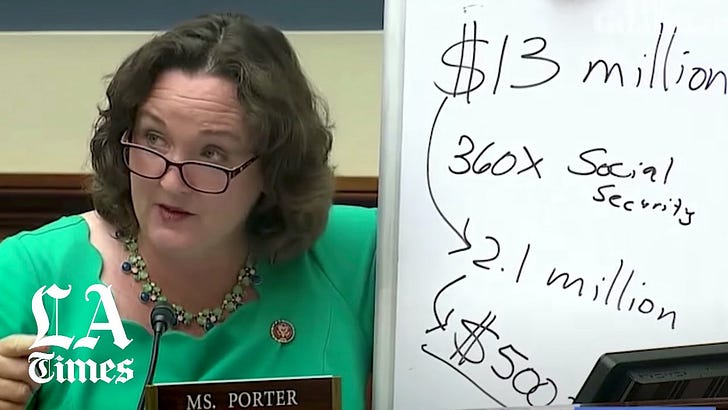
Using A Whiteboard during High Conflict Meetings Is My Superpower
Be the Katie Porter of Family Meetings
If you follow American politics, you have likely seen California congresswoman Katie Porter’s whiteboards. She wields her dry-erase markers like lassos of truth, breaking down complex topics and using the board to maintain focus.
I’m going to teach you how to do something very similar to support your next complex patient care meeting. (You can actually use this for almost any high-stakes meeting)
Unlike Ms. Porter, I’m not using whiteboards to take down greedy executives in political committees. I’m using them to help patients and families get the information they need and to help clinicians clarify how they align treatment with the family’s goals.
Clinicians have family meetings regularly. As an ethics consultant, I typically get asked to join when there is high conflict. Usually, the clinicians and family feel they are not making much progress or are having escalating disagreements.
I’m a big fan of shared agenda-setting and visual representations of conversions. These both flatten the family-clinician hierarchy and make our shared goals super clear.
Enter the Whiteboard!
Using a whiteboard in a high-conflict meeting can be highly effective for several reasons.
Here are Five Key Benefits to Whiteboarding in Family Meetings:
Visual Aid for Clarity: Whiteboards provide a visual component to the discussion, which can help clarify complex points or ideas. By diagramming, listing, or mapping out issues, everyone in the meeting can have a clearer understanding of the topics being discussed. This clarity can reduce misunderstandings and help keep the conversation focused. I start meetings by making a collaborative agenda and writing it on the board. This helps everyone remember our agreements.
Neutralizes the Atmosphere: A whiteboard can act as a neutral space in a high-conflict environment. Instead of direct confrontations between individuals, the whiteboard becomes the focal point of the discussion. This shift can help de-escalate tensions and facilitate a more objective and less emotionally charged dialogue.
Encourages Participation: A whiteboard can encourage more interactive and balanced participation. Instead of one person (usually a physician) dominating the conversation, different people can contribute their ideas or points directly on the board. In a family meeting, I always start by asking the family what their goals are for the meeting. Everything they bring up (no matter how small), goes on the board. Clinicians get to add to the agenda afterward. This inclusivity can help flatten the hierarchy and ensure that all perspectives are considered, making participants (especially patients and families) feel heard and valued.
Tracks Progress & Agreements: During a high-conflict meeting, it's easy for participants to go off track or revisit the same issues repeatedly. A whiteboard allows for tracking the progress of the discussion and noting down agreements or decisions as they are made. This record-keeping is essential for keeping the meeting on track and for referencing after the meeting concludes.
Facilitates Problem Solving and Brainstorming: Whiteboards are excellent tools for brainstorming solutions and problem-solving. They allow for the visual organization of thoughts, making it easier to see connections, identify underlying issues, and develop creative solutions. This can be particularly beneficial in a high-conflict situation where new perspectives or approaches are needed to resolve the conflict. I also cross off previously considered solutions that have already proven ineffective. This visual reminder of what’s already bee tried helps people make peace with what’s left to choose from.
Overall, a whiteboard can transform the dynamics of a high-conflict meeting by promoting clarity, participation, organization, neutrality, and creative problem-solving.
Are you ready to try be like Katie Porter in your next complex family meeting? What would help you try it out?
Grab your dry-erase markers and give it a try!
















